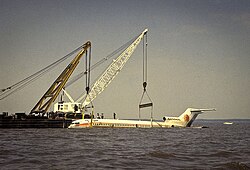Flight crew
The crew consisted of Captain George T. Kunz (age 55), employed by National Airlines since 1956, who had qualified to fly the Boeing 727 in 1967 and accumulated 18,109 flight hours in his career with 5,358 hours on the Boeing 727; First Officer Leonard G. Sanderson Jr. (31), employed by National Airlines since 1976, with 4,848 flight hours of which 842 hours were on the Boeing 727; and Flight Engineer James K. Stockwell (47), employed by National Airlines since 1969, with 9,486 flight hours of which 7,050 flight hours were on the Boeing 727.
Accident analysis
Contributing to the crash was poor preparation on the part of the flight crew. While the captain and first officer were aware that runway 16 was closed, they had both forgotten it. A visual approach slope indicator (VASI) light system serving runway 25 was available and operational, but while the information was available to the flight crew, the flight crew was unaware of this alternate approach aid. [1]
An additional contributing factor to the crash was an error on the part of the radar controller. Procedure for runway 25 was to direct flights to intercept the final approach at 8 nmi, with the approach gate at 6 nmi. The controller misjudged the aircraft's distance and turned it to final inside the recommended distance, resulting in the aircraft being on final approach vector at about 4.5 nmi, close to half the distance of a normal approach. The NTSB report concludes the controller "created a situation that would make it impossible for the captain to configure his aircraft in the manner specified in the flight manual". [1]
A reluctance to declare a missed approach pervaded the descent. Radar controller, captain, first officer and flight engineer all had indications of an out of the ordinary approach, producing a rushed and busy environment. An example of this was that the captain failed to lower the landing gear immediately after lowering the flaps to 25 degrees, because he "wanted to avoid placing a simultaneous demand on the hydraulic system while the flaps were in transit". Similarly, the first officer never made the required 1,000-ft callout, because he never got to 1,000 ft mentally, because of his "inner time clock" which was based on a normal descent rate. In addition, each person chose not to ask for or offer additional assistance or warnings, including recommended announcements and acknowledgments. The lack of crew communication and a "no problem here" attitude resulted in false awareness of altitude and descent rate on the part of all involved. [1]
This page is based on this
Wikipedia article Text is available under the
CC BY-SA 4.0 license; additional terms may apply.
Images, videos and audio are available under their respective licenses.

